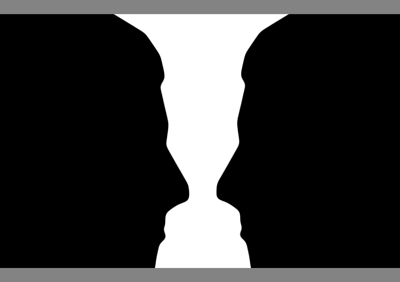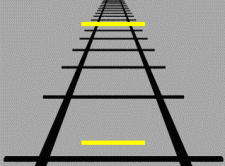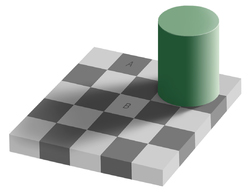Afterimage Illusions
Afterimages are images that remain in one’s vision after its initial exposure is gone. If you were to stare at the above afterimage for 30 to 60 seconds and then look at a blank white screen you will see a clear picture of Jesus. There are 2 main things that cause this type of effect. The first is the adaptation in the firing rate of ganglion cells in the retina. When ganglion cells become excited or unexcited for a long period of time, they produce a rebounding effect, firing these ganglion cells at a faster or slower rate than normal. The second reason for this occurrence is because of the eye’s photoreceptors, mainly the cone cells, becoming over stimulated and then desensitized or fatigued.
Ambiguous Illusions
What do you see in the image above? Is it 2 faces or a vase? These ambiguous illusions are determined by the way each individual perceives shapes and edges. When we view the world, we categorize most of what we see as either an object or a background. Psychologists define these terms as figures and grounds. Depending on how we look at things, objects can be seen as backgrounds and vice versa. For example, if we were to focus our eyes on the inner curved edges of the image, we would see the white vase as the object surrounded by a black border. However, if we were to view the curved lines in an outward fashion, we would see 2 faces as the object in front of a white background.
Illusions of Depth
The Ponzo illusion is an optical illusion that plays with the idea of depth. The top line appears to be longer than the bottom but in reality both lines are the same length. Our mind sometimes determines the size of the object based on distance and the surrounding background in which it is placed. In this example, the two converging vertical lines represents as a background for a railway track. The way these lines are angled and converge creates what psychologists call a linear perspective. This produces a sense of depth or distance in our visual field and that is why the upper line looks longer than the bottom.
Illusions of Colour and Brightness
The squares “A” and “B” are the same shade of grey. Don’t believe me? Put this image into Photoshop and extract the colours from both squares and you will see that I’m right. This optical illusion is commonly known as Adelson’s checker shadow illusion or the same colour illusion. The discrepancy of grey cast by the cylinder’s shadow and the lighter greys outside of the surrounding shadow, makes our eyes compensate for the colour contrast giving the illusion that the 2 squares are completely different shades.




Leave a comment